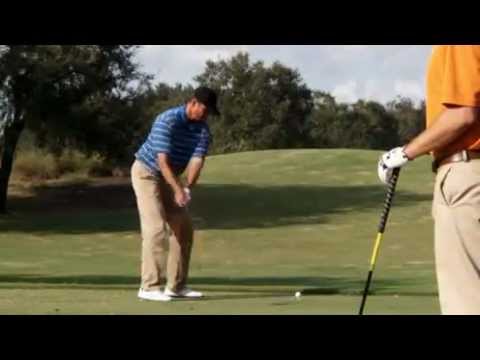Featured Product:
Old Guys Rule T-Shirt Golf 19th Hole-Xxl
- High Quality Item
- Retirement Gift
- Satisfaction Guarunteed
- Choose Your Size and/or Color if Applicable
This listing is for a officially licensed Old Guys Rule t-shirt.
List Price: $ 25.99
Price: [wpramaprice asin=”B007K6EW0Q”]
Golfer’s Guide to Rules and Etiquette
The Golfer’s Guide to Rules and Etiquette has been written to help eliminate the novice golfer’s awkwardness and unfamiliarity with the many behavioral nuances of golf and to encourage him or her to develop their own game in such a way that golf
Price: [wpramaprice asin=”B00AEBDE9E”]









In the instance where the ball is hit into the ditch you state that the
player CANNOT hit from the far side of the hazard on a line that dissects
the point of entry and the flag because he would be in the forest. Although
I would agree he would be ill advised to do so he still has that option.
Confusing for someone trying to learn the rule. Propose that it would have
been clearer had you left out the forest and made it a field and thus been
able to illustrate this fifth option. Great vid series
MyGodlover1, If you find your ball in the water hazard you pick-up any
provisional ball played and proceed by playing your ball as it lies or
taking one of the options for relief under penalty of one stroke under Rule
26-1. If you don’t find your original ball, it is lost. You play the
provisional ball, if you have played one, or return to where you made your
previous stroke from under penalty of stroke and distance under Rule 27-1.
Barry
Devin, Details of my eBook, ‘999 Updated Questions on the Rules of Golf’,
and other useful products on the Rules of Golf can be viewed at my web
site, which is referenced in the video description. Barry
Cheerio!
These are excellent videos and encourage more of them. I help with high
school golfers and the standard rule book is difficult to work thru to find
answers. Great job!
may i ask is grounding of club means the club not even touching the grass?
if yes then what happens if the hazard grass is a foot high?
What if you couldn’t see we’re your ball went into the hazard due to trees
or hills?
Thank you for all your information, My last question is why are all hazards
call water hazards even though there is no water or am i wrong about that??
In a recent tournament we had a rule dispute. The water hazard was red
staked but only two stakes were present on the pond, one at an end point,
and one at a point where the pond was smaller than the rest of it, so it
was not round but irregular in shape. The ball was outside both stakes but
in the water. the golfer said their ball was not in the hazard because the
pond was over-flowing (the pond is shallow and has not banks) and they
wanted to take a free drop because of casual water.
The Peebsb, Indeed, you can. The first relief option in Rule 26-1 is to go
back and play from where you last played from, under penalty of stroke and
distance. If the last place you played from was the teeing ground then you
may re-tee your ball and play from anywhere in that teeing ground. Barry
Thanks again Barry, think I’ve got that now:-) Your videos are most lucid
but the doubt stemmed from the absence of emphasis on going back along the
line (from hole through pt. of hazard crossing) which would seem a great
option all round. Your opening remarks do clearly say “additional options”
but at 1min 17sec you refer to “two” options for LWH when a 3rd (going back
along line) is also available. At 2m 32s you say “one further option” which
skips the best one? Keep up the good work!
Thanks for your explanation. It was so clear and helpful.
@robertskwh Decision 13-4/8 tells us that grounding a club in a water
hazard occurs when the grass is compressed to the point where it will
support the weight of the club. But don’t confuse anything that is growing
with anything natural that is not attached. For example, a player may not
touch loose leaves in a water hazard with their club as they prepare to
make their stroke. Barry Rhodes (Author of the book ‘999 Questions on the
Rules of Golf’)
Great videos. Good work. You make it very simple and easy to understand.
@Ninjaw78 Let me start by saying that I do not claim any expertise on
course set-up and recommend that you address your query to your national
golfing body. In my opinion the options are to define the area as a lateral
water hazard (penalty drop), GUR (free relief), out of bounds (stroke and
distance penalty) or play the ball as it lies with players taking the ball
unplayable penalty option if necessary. Personally, I do not think that
designation as a water hazard is appropriate. Barry
@9ty9 yes i know that ,i should have wrote tree hazard with red stakes. my
point is i was playin a par 3 and hit into the woods with red stakes but
the stakes were 5 feet into the tree line and when i was dropping two club
length it was rolling back into the tree line(to where i wouldnt have a
shot or be able to make a proper swing) but when i was dropping it still
wasnt rolling past the red stakes so i picked up and redropped twice and my
buddy was charging me 2 strokes everytime.
Longest club is fine.
@82PeRK The first point to note is that trees on a course are not hazards.
The only hazards in the Rules of Golf are water hazards (yellow stakes
and/or lines), lateral water hazards, (red stakes and/or lines) and sand
bunkers. However, Rule 27-1 states that at any time, a player may, under
penalty of one stroke, play a ball as nearly as possible at the spot from
which the original ball was last played (see Rule 20-5). This is proceeding
under penalty of stroke and distance. Barry Rhodes
Provided you find your ball within the margins of the water hazard you
estimate where it last crossed the margin. Otherwise you have to assume
that your ball is lost and go back to where you last played from under
penalty of stroke and distance. Barry
im i allowed to re tee on the tee box if it went in to a hazard (not water
hazard) just a regular hazard that went into the trees????
Barry, a point that came up for debate amongst my fellow golfers today:
most think that for Lateral hazard one can go back along line as per
“yellow stakes” option but no further than 2 club lengths. This is my
understanding from your video also. However, Rule 26-1 suggests the
2-club-length option is ADDITIONAL to the “yellow stakes” options viz (a)
play from last play position or (b) go back along line of hole/pt of entry!
What are we missing? Your assistance please? Thanks – Cyril
Cardn2, I hope that you and your league members are familiar with my weekly
blog site (see the link at the description of this video above) and my new
web site for anyone who wishes to improve their knowledge and understanding
of the Rules of Golf, Rhodes Rules School. Barry
Thanks Blue Jeans, you are welcome to use any of my short videos on the
Rules of Golf on your blog site. Regards, Barry
@82PeRK When a player chooses to return to the teeing ground, under penalty
of stroke and distance, the ball to be played must be played from within
the teeing ground. It may be played from anywhere within the teeing ground
and may be teed, Rule 20-5a. Barry
Cardn2 You are absolutely right. I should not have used the word “can’t” in
that situation; I should have used the word “impracticable”. In my defence,
it is easy to make that kind of mistake when you are not working from a
prepared script. Thanks for pointing it out. Barry